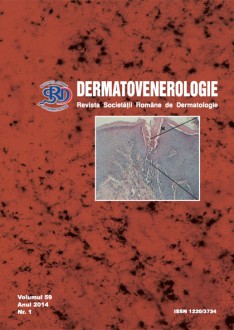Boala Darier-White, cunoscuta si sub denumirea de (dis)keratoza foliculara, reprezinta o genodermatoza rara, cu transmitere autosomal dominanta, descrisa pentru prima oara in 1889, atat de Ferdinand-Jean Darier, cat si de catre J.C. White, acesta din urma semnaland si agregarea familiala a afectiunii [1,2,3,4]. De-a lungul timpului au existat numeroase ipoteze in privinta etiologiei bolii, insa in prezent se considera ca aceasta este cauzata de producerea unor mutatii la nivelul genei ATP2A2, ce codifica ATP-aza Ca2+-dependenta a reticulului sarco/endoplasmatic (SERCA2), rezultand tulburari ale transportului intracelular al calciului si semnalizarii calciu-dependente [1,2,4].
Debutul keratozei foliculare se produce cel mai frecvent in primele doua decade de viata, fara o distributie preferentiala pe sexe sau grupuri etnice [1,2,4]. Afectiunea este caracterizata clinic prin aparitia de papule keratozice foliculare grasoase galben-maronii, ce tind sa se grupeze in placi si placarde imprecis delimitate, cu distributie simetrica specifica in regiunile seboreice [1,2,4,5]; aproximativ 80% dintre pacienti prezinta leziuni localizate la nivelul pliurilor (axilar, submamar, inghino-perineal), ce pot evolua inspre forme vegetante, cu miros fetid [6,7].
Aceste manifestari pot fi insotite de modificari unghiale tipice, papule keratozice localizate la nivelul fetelor dorsale ale mainilor si picioarelor, hiperkeratoza punctata palmoplantara, precum si leziuni mucoase [1,2,4,6].
Evolutia bolii Darier este cronica, recidivanta, desi s-a constatat posibilitatea ameliorarii manifestarilor clinice odata cu inaintarea in varsta [7]. Tratamentul prezinta un caracter paliativ, incluzand metode de profilaxie (fotoprotectie, emoliente, anti-inflamatoare si antiseptice locale), terapia medicamentoasa topica si sistemica (retinoizi aromatici, corticoizi, 5-fluorouracil), precum si multiple alternative chirurgicale (dermabraziune, electroterapie, tratament laser, terapie fotodinamica, excizie chirurgicala) [1,2,4].
In cadrul lucrarii de fata prezentam cazul unei paciente in varsta de 37 de ani, cu un grad minim de retard mental, cunoscuta cu afectiuni asociate din sfera endocrinologica, care a solicitat internarea in clinica noastra in urma aparitiei unor leziuni papulare pruriginoase, hiperpigmentate, de culoare maroniunegricioasa, debutate in urma cu circa 13 ani, initial axilar, extinse ulterior si la nivelul extremitatii cefalice, toracelui si regiunii genitale. In urma efectuarii anamnezei si examenului clinic obiectiv a fost ridicata suspiciunea de acanthosis nigricans tipul 2, aparut in contextul tulburarilor endocrine asociate, insa examenul histopatologic al materialului bioptic prelevat de la bolnava a stabilit diagnosticul de certitudine – boala Darier.
Referate generale
BOALA DARIER: CONSIDERATII ETIOPATOGENICE, ANATOMO-CLINICE sI DE DIAGNOSTIC DIFERENTIAL


